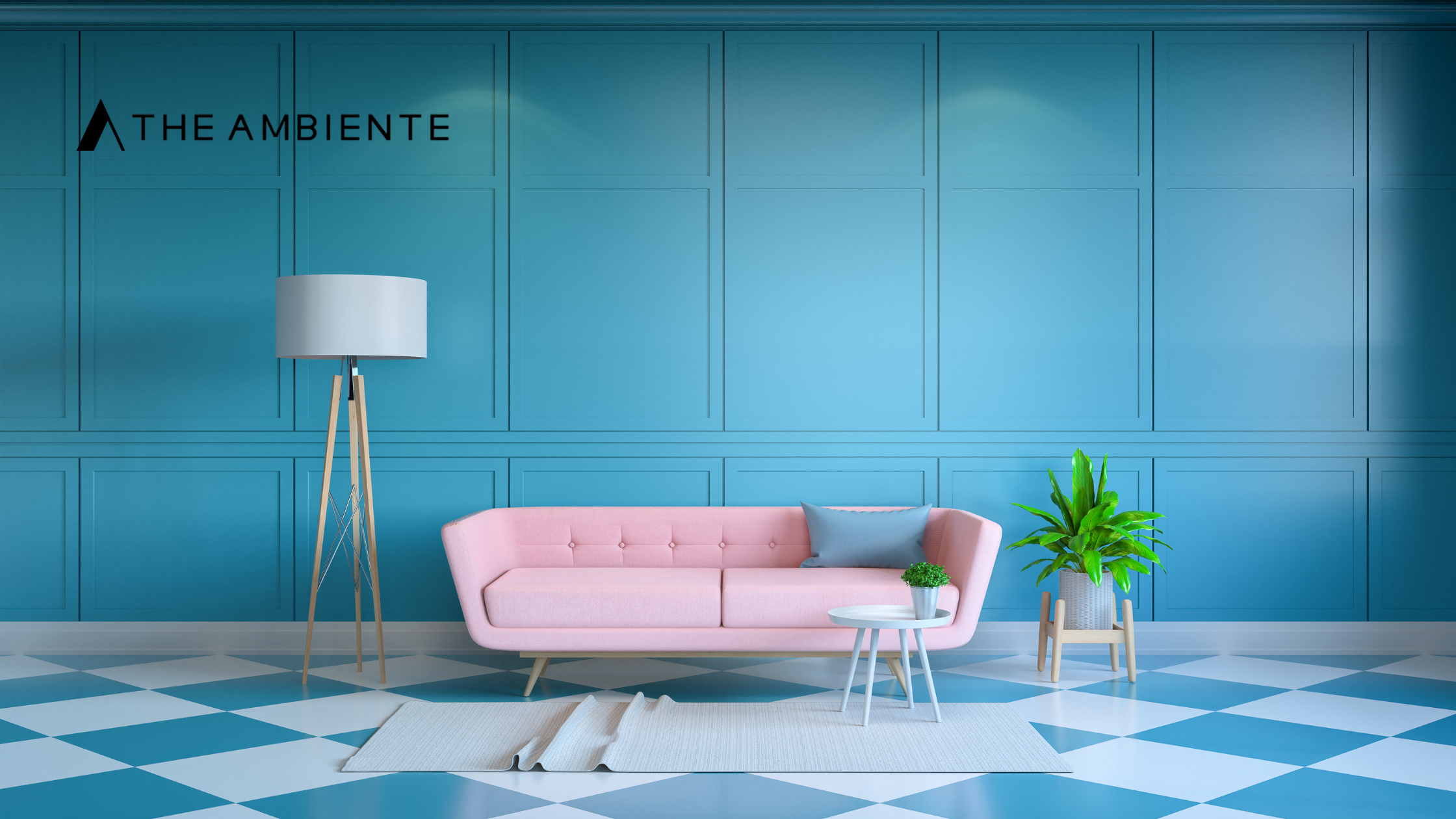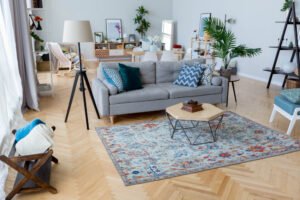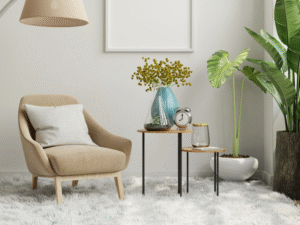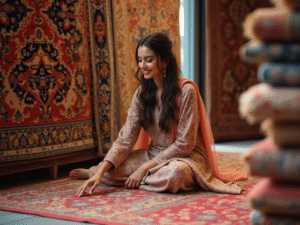Selecting the perfect rug for your living room can be a transformative decision, significantly impacting the overall aesthetic and comfort of the space. With countless options available, from size and material to color and pattern, the process can feel overwhelming. This guide will walk you through the essential considerations to ensure you choose a rug that complements your living room beautifully.
1. Understand the Role of a Rug in Your Living Room
A rug in a living room serves multiple purposes beyond just covering the floor. It can:
- Define the Space: In open-plan homes, a rug can delineate the living room area, creating a distinct zone.
- Add Warmth and Comfort: Rugs offer a soft surface underfoot, making the room feel cozier and more inviting.
- Enhance Aesthetic Appeal: With the right choice of color, pattern, and texture, a rug can tie together the room’s decor elements, adding depth and interest.
Understanding these roles helps in prioritizing what matters most for your specific living room needs, whether it’s enhancing warmth, adding a splash of color, or creating a clear boundary in an open space.
2. Consider the Size: Get It Just Right
The size of the rug is one of the most critical factors. A rug that’s too small can make the room feel disjointed, while one that’s too large might overwhelm the space.
A. Measure Your Space
Start by measuring your living room, focusing on the area where you plan to place the rug. Ideally, the rug should fit under the front legs of your furniture or encompass all the furniture entirely. Here are some standard size guidelines:
- Small Living Rooms (up to 12×18 feet): A rug size of 5×8 feet typically works well. Place it under the front legs of your sofa, leaving some floor space around the edges.
- Medium Living Rooms (12×18 to 14×20 feet): A 6×9 or 8×10 feet rug can help ground the space, ensuring that the front legs of your furniture are on the rug.
- Large Living Rooms (over 14×20 feet): Consider a 9×12 feet or larger rug that fits all furniture comfortably within its perimeter.
B. Furniture Placement and Rug Size
When choosing a rug size, consider how your furniture will sit on the rug. There are three common approaches:
- All Legs on the Rug: This creates a cohesive look, especially in larger rooms. It helps unify the space by keeping all furniture pieces on the rug.
- Front Legs on the Rug: Ideal for medium-sized rooms, this option allows the rug to extend slightly beyond the furniture, anchoring the space without overwhelming it.
- Just the Coffee Table on the Rug: For smaller rooms, or if you have a beautiful floor that you don’t want to cover completely, placing only the coffee table on the rug can work well.
3. Material Matters: Choose the Right Fabric
The material of the rug affects not only its look and feel but also its durability and maintenance needs. Here are some common rug materials to consider:
A. Wool
- Pros: Wool is a popular choice due to its softness, durability, and natural stain resistance. It also has excellent insulation properties, making it a great option for adding warmth to your living room.
- Cons: Wool rugs can be more expensive and may shed initially, requiring regular vacuuming.
B. Cotton
- Pros: Cotton rugs are affordable, easy to clean, and come in a variety of patterns and colors. They are a great option for casual, laid-back spaces.
- Cons: Cotton is less durable than wool and may show wear more quickly, especially in high-traffic areas.
C. Synthetic Fibers (Polyester, Nylon, Polypropylene)
- Pros: Synthetic rugs are generally more affordable, resistant to stains, and easy to clean. They come in various designs, mimicking the look of natural fibers.
- Cons: They may not feel as luxurious as natural fibers and can sometimes have a shorter lifespan.
D. Natural Fibers (Jute, Sisal, Seagrass)
- Pros: Natural fiber rugs add a textured, organic look to the room. They are durable and eco-friendly.
- Cons: These rugs can be rougher underfoot and are more challenging to clean, as they are prone to staining from spills.
4. Color and Pattern: Complementing Your Decor
The color and pattern of your rug can either blend with your existing decor or become a statement piece. Here’s how to choose the right combination:
A. Color
- Neutral Tones: If your living room is already vibrant, a neutral-colored rug can ground the space without clashing with other elements. Shades like beige, gray, or cream are versatile and timeless.
- Bold Colors: A rug in a bold color can become the focal point of the room, especially if the rest of your decor is more subdued. Consider colors that complement your existing palette or create a striking contrast.
- Multi-Colored Rugs: These can tie together various colors in your room, making the space feel cohesive. However, ensure that the pattern isn’t too busy if your room already has a lot of visual elements.
B. Pattern
- Solid or Subtle Patterns: For a minimalist or modern look, opt for solid colors or subtle patterns like tone-on-tone designs. This keeps the focus on other elements of the room.
- Geometric Patterns: These work well in contemporary or eclectic spaces, adding a dynamic element to the room.
- Floral or Oriental Patterns: These timeless designs add a touch of elegance and work well in traditional or transitional decor styles.
- Abstract Patterns: Perfect for modern and artistic interiors, abstract designs can bring a creative flair to your living room.
5. Texture: Adding Depth and Comfort
The texture of your rug plays a crucial role in how it feels underfoot and how it contributes to the overall vibe of the room. Here are some texture considerations:
- Shag Rugs: These have a deep, plush pile that’s soft and cozy, ideal for adding warmth to your living room. However, they can be harder to clean and may not be suitable for high-traffic areas.
- Flatweave Rugs: These rugs have a smooth, low pile, making them easier to clean and ideal for busy areas. They work well in casual or modern spaces.
- Hand-Knotted Rugs: Hand-knotted rugs, especially those made of wool or silk, offer a luxurious texture and intricate design. They are often more expensive but can be a stunning focal point.
6. Maintenance: Keeping Your Rug Looking New
The longevity of your rug depends on how well you maintain it. Here are some tips for keeping your living room rug in top shape:
- Regular Vacuuming: Vacuum your rug regularly to remove dust and dirt. Be gentle, especially with delicate fibers like wool or silk.
- Rotate Your Rug: Rotate the rug every few months to ensure even wear, especially if it’s in a high-traffic area.
- Spot Cleaning: Address spills immediately to prevent stains. Blot the area with a clean cloth and use a mild detergent if necessary.
- Professional Cleaning: Consider professional cleaning for deeper stains or at least once a year to keep your rug looking fresh.
Conclusion: The Perfect Rug Is the One That Fits Your Style and Needs
Choosing the perfect rug for your living room is a blend of practical considerations and personal style. By taking into account the size, material, color, pattern, texture, and maintenance needs, you can find a rug that not only enhances your living room’s aesthetic but also adds comfort and warmth to the space.
Remember, the right rug is one that makes you feel at home, tying together all the elements of your living room into a cohesive, inviting space. So take your time, explore different options, and trust your instincts—you’re sure to find the perfect rug that you’ll love for years to come. 😊





